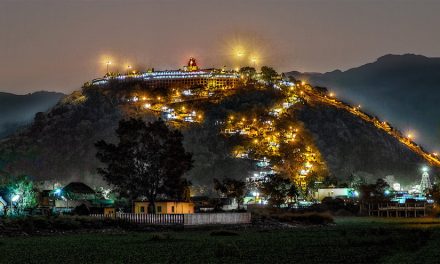Sonamukhi, a municipal town located 42 km from Bankura and 36 km from Bishnupur, is connected by motorable roads, and regular bus service makes the area easily accessible to pilgrims and visitors. This town was mentioned in 17th century manuscript, Deshaabali-bibriti written by Jaganmohan Pundit, as a village of weavers (Tanti). Even during East India Company rule this was a very big trading centre for cotton, silk, lac and neel. According to local people, the name Sonamukhi is derived from the ancient village deity, “Swarnamukhi”, a Saalagram Shila Who is still worshiped in a brick built Dalan mandir in the centre of the town.
Sridhar Mandir
The Sonamukhi Sridhar Mandir is a 25-ratna, west facing temple situated in the Bazarpara (marketplace), and it is the only 25-ratna mandir in all of Bankura district. Built by Kanai Rudra, a member of the weaver community, in 1845 A.D. (1252 B.S.), it features brick with all four sides and the pillars being covered with terracotta plaques. On all four sides are found three arches each, with a porch provided only on the west side.
Except for Jorbangla mandir and Shyama-raya mandir in Bishnupur, there is probably no other temple in the Bankura district having terracotta plaques. One cannot imagine any plausible explanation for such elaborate artwork here, except for the local story, which attributes it to Kanai Rudra, a very rich merchant of Sonamukhi. He wanted to build a temple and engaged Hari Sutradhar for that purpose. He instructed him to build a beautiful temple decorated with terracotta plaques and to not worry about the cost.
Krsna and Gopis
After completion of the work by Sutradhar, Kanai Rudra came to visit the structure. He was not satisfied, as the temple was not fully covered with terracotta. So he told Hari Sutradhara: “What you have done would not dent my purse to the slightest. Do something more!” So the mason went back and completely covered the structure, making it an enormous artwork in terracotta. While the fineness of its artwork may not be comparable to terracotta works on other temples in Bishnupur, it certainly competes with that of other Bankura temples. Beyond that, however, Sridhar Mandir is unparalleled in terms of the diversity of themes in the lila narrative depicted on the terracotta panels.
Exchange of Babies after Krsna’s Birth
In fact, Sridhar mandir is a transcendental treasure trove. We find here not only beautifully crafted episodes of Ramayana, Mahabharata, and Purana (Shaiba, Sakta, Vaishnav), but also an extraordinary collection of scenes from Krsna lila, shown here. These delightful lila narratives are offset by various other social scenes including foreign visitors, animals, birds, ornamental and floral designs.













